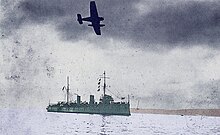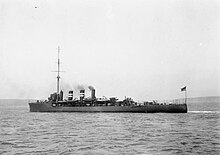Scout cruiser
Scout Cruiser (German about scout cruiser , scout cruiser or scout cruiser ) refers to a military vessel type , that of the Royal Navy (and to a lesser extent by the US Navy ) in the first years of the 20th century to the run-up to the First World War was built. These were cruisers that, at the expense of armament and armor, had a high speed for their time and the size of the ship. The ships were designed as a fleet reconnaissance and heavy flotilla commanders . Among other things, a scout cruiser was supposed to drive ahead of a destroyer association as a lead ship and scout out targets for the smaller destroyers.
The Italian Esploratori and the Austro-Hungarian rapid cruisers represented comparable ship types . In 1916, the German Reich planned a " Spähkreuzer "; however, the project was not implemented.
With the development of faster and more powerful destroyers, the British scout cruiser concept was already considered obsolete before the start of the world war. Follow-up projects were no longer classified as Scout Cruiser by the Royal Navy from 1913 . In the 1920s, the fleet conferences defined the internationally common designation light cruiser for cruisers of comparable size, regardless of their task and armor .
At the turn of the century, the Royal Navy classified its armored cruisers and armored cruisers as 1st , 2nd and 3rd class cruisers based on size and combat power . In 1901/02 the Admiralty developed the concept of the Scout Cruiser to complement these three classes . These should be even weaker armed and armored than the third class cruisers, but have a significantly higher speed than all other cruisers in order to be able to be used together with the destroyer flotillas and as a fast reconnaissance aircraft. The area of operation should be limited to the North Sea and the waters of the British Isles.
In May 1902 the concept was published as a tender. The ships to be built should reach at least 25 knots (46 km / h) (other cruisers reached a maximum of 23 knots at this time). The ships should furthermore an armored deck equipped with six 12-Pounder- and eight 3-Pounder - rapid-fire guns and two 18-inch torpedo tubes be equipped. 2000 nautical miles were sufficient as an operational range.
The Admiralty finally accepted the designs of four ship manufacturers and ordered a ship from each shipyard as part of the 1902/03 naval building program. A year later, a second ship was requested from each shipyard. Even during construction, the armament was classified as inadequate and increased by four additional 12 pounds per ship.
| Ships | Shipyard |
|---|---|
| Sentinel , skirmisher | Vickers , Barrow |
| Adventure , Attentive | Armstrong-Whitworth , Elswick |
| Forward , Forsight | Fairfield , Govan |
| Pathfinder , Patrol | Cammell Laird , Birkenhead |
For the fact that they were developed independently by four manufacturers, the ships differed only relatively slightly. All ships were between 110 and 114 meters long, about 12 meters wide and had a draft of about 4 meters. The displacement was between 2670 and 2940 long tons . Despite the armament and armor, the required 25 knots were achieved using two coal-fired triple expansion steam engines . The crew was about 270 men.
The American Navy built from 1905 - presumably as a reaction to the British designs - the experimental Chester class , the three ships of which Chester , Birmingham and Salem were classified as Scout Cruiser and reached 24 knots. Each of the ships had a fundamentally different propulsion system for testing purposes.
After the completion of the class in 1908, the United States completely stopped cruiser construction by 1917. The Omaha class developed at that time was also classified as a Scout Cruiser during the planning phase .
Peru and Brazil

Since the Admiralty did not commission any more scouts, the British manufacturers began to look overseas for interested parties. Vickers built the Almirante Grau and the Coronel Bolognesi for the Peruvian Navy from 1905–1907 . Armstrong-Whitworth built the Bahia and the Rio Grande do Sul for the Brazilian Navy from 1907 to 1910 .
In South America these ships were among the largest warships and were classified as cruisers ( crucero or cruzador ). They remained in use until after the Second World War.

Between 1907 and 1911, the Royal Navy finally commissioned three further series for Scout Cruisers from the Pembroke Dockyard . These ships were significantly heavier (around 3300 long tons) than the old Scouts and instead of the now completely outdated coal steam engines, they were equipped with modern Parsons steam turbines .
For unclear reasons, however, the new ships did not reach any higher speed than the first series. The ships were in fact already out of date when they were commissioned, as they were significantly slower than the new destroyers they were supposed to be leading.
| Ships | Shipyard |
|---|---|
| Boadicea , Bellona | Pembroke Dockyard |
| Blonde , Blanche | Pembroke Dockyard |
| Active , Amphion , Fearless | Pembroke Dockyard |
Because of the little success of the "Scouts", the classification was no longer used after the completion of the HMS Fearless in 1913. Instead, the scout cruisers were combined with the new overseas long-range cruisers of the Town class and referred to as light armored cruisers . The indirect follow-up projects of the Scouts, the Arethusa class and the very successful C class , came under this name. After the war they became the “light cruisers”, while the previous first class cruisers were only referred to as “cruisers”.
Web links
- John Rickard: British Cruiser Classes of the First World War , www.historyofwar.org, 2007 (accessed January 2017)
- World War 1 Naval Combar: British Light Cruisers (accessed January 2017)
Individual evidence
- ^ So named in: Yearbook for Germany's Seeinteressen 1909 , Verlag ES Mittler
- ↑ so called in: Oswald Flamm : Schiffbau: Journal for the entire industry in shipbuilding and related areas, Volume 8 , Berliner Union Verlagsgesellschaft mbh, 1907, p. 737
- ↑ so called in: Oswald Flamm: Schiffbau: Journal for the entire industry in shipbuilding and related areas, Volume 6 , Berliner Union Verlagsgesellschaft mbh, 1904, p. 441
- ^ Norman Friedman: British Destroyers From Earliest Days to the Second World War , Naval Institute Press, Annapolis 2009, pp. 99-101
- ^ Emil Guarini: The English Scout-Cruiser Sentinel , In: Marine Engineering , Volume 10, September 1905, p. 363
- ↑ US Naval History and Heritage Command: Chester I , Birmingham I , Salem I
- ↑ Harlow A. Hyde: Scraps of Paper: The Disarmament Treaties Between the World Wars, Media Publishing, Lincoln, 1988, p. 103
- ↑ Norman Friedman: British Destroyers From Earliest Days to the Second World War , Naval Institute Press, Annapolis 2009, pp. 111-113
- ↑ John Roberts: To Crown the Waves: The Great Navies of the First World War (edited by Vincent O'Hara), Naval Institute Press, Annapolis 2013, Chapter 4: Great Britain: The Royal Navy (pp. 129ff), section “ The Ways of War, Cruisers "

